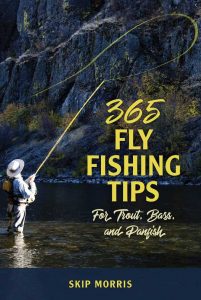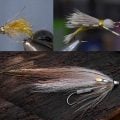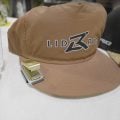Seven New Fly Fishing Tips
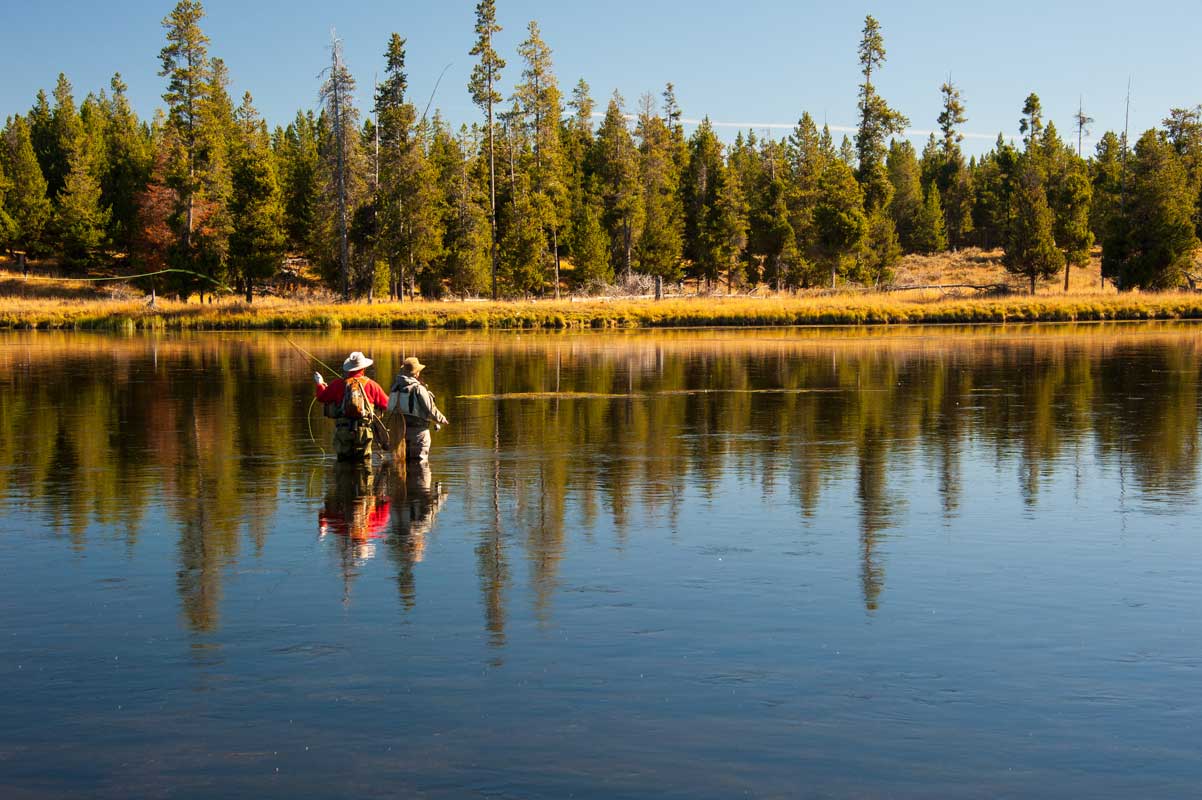
See Tip #370 below: Here we have the delightfully infuriating Henry’s Fork, a huge spring creek whose rainbows are famously difficult to fool and will point a pectoral fin and laugh sardonically at a fly dragging even slightly across the current. Is this a good place to introduce a newbie to fly fishing? If your answer is Yes, are you mad? | Carol Ann Morris photo
I wrote a book titled 365 Fly-Fishing Tips for Trout, Bass, and Panfish but, in fact, if you include the short extra tips the book calls “bonus tips,” there are 399 tips altogether. It’s fortunate, at least in this one regard, that I’m now an old fly fisher: no one under, say, 55, is likely to have had time to collect so many genuinely useful tips.
Would I trade having written this book for a shot at returning to age 40? Well, I’m purely pleased with how the book came out—the photos and illustrations, the principals within the tips themselves, even the entertainment quality of the book overall. Still, 40 sounds pretty good…. Please: don’t tempt me.
Anyway, by the end of the four years I spent jotting down and collecting up and recalling nearly a lifetime’s accumulation of ideas, principals, techniques, rigs, strategies, sound shortcuts, and all the rest for the book, I had become a tip hunter. In me had grown an urge to analyze every aspect of my fishing, when I was fishing, of course, but even when I was only reading about or thinking about fishing. The desire to uncover ways to make others’ fishing easier, more efficient, more effective, more enjoyable, by chasing down tips: that desire didn’t go away the moment I sent the manuscript off to Stackpole Books. So on I went, finding tips as the urge to hunt them persisted. As usual, some weren’t, but a few were, up to snuff. When I had collected seven dandy new tips, I started working on this article.
So, here are the best new (or newly remembered) fly-fishing tips since the book. (They’re presented differently here than in the book, that is, with a different layout and without the symbols indicating the fishes and waters to which each tip applies. But the editor and I worked around all that just fine.) The book ends with tip number 365. So, we begin with . . .
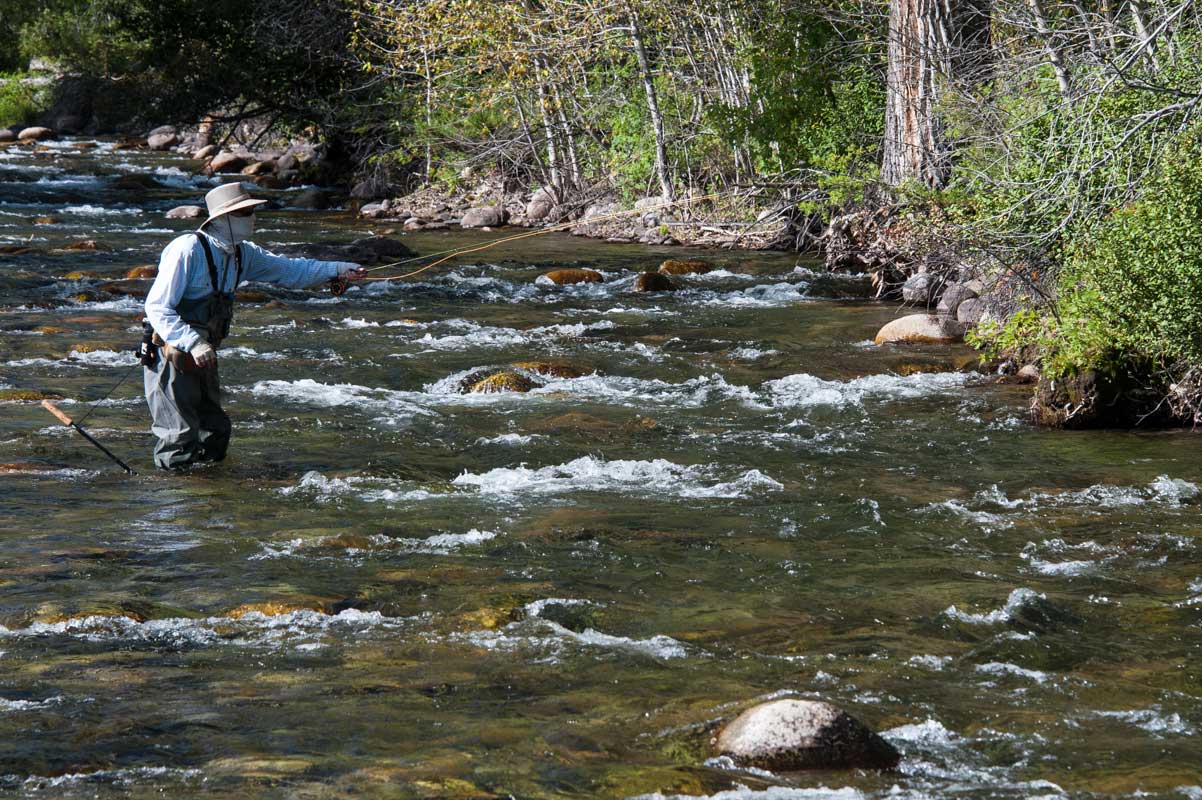
There’s the classic Czech-nymphing pose: rod extended, slight tension on the deep, drifting flies. Same pose whether you use a sighter or you use a strike indicator in place of a sighter. | Carol Ann Morris photo
Tip 366
How to Quick Switch Between Czech and Indicator Nymphing
(This tip applies to trout in streams and possibly smallmouth bass in streams.)
“Czech nymphing” (lobbing a rig of two or more nymphs upstream and then leading them downstream with the rod-tip to maintain light tension as the nymphs drift) normally involves a sighter. A typical “sighter” is around two feet of brightly colored monofilament set into the leader and held above the water during the nymphs’ drift. A sighter tells—if a trout touches a nymph, the sighter stalls or quivers or does something to alert the angler.

A multiple-nymph rig, no indicator but a sighter instead, the flies lead downstream slightly with the rod-tip—that’s Czech nymphing. | Carol Ann Morris illustration
An earlier approach, “indicator nymphing,” if you don’t know it, is one or more nymphs below a “strike indicator,” a buoyant tiny ball or a wad of buoyant yarn or the like. The indicator floats, the nymphs hang below it. If the indicator dives or stalls or behaves unnaturally even in the slightest, the angler sets the hook.
I switch from Czech nymphing to indicator nymphing and back often during a day’s fishing on a trout stream. But such switching normally requires significant time and fuss to re-rig. Want to avoid nearly all that fuss and lost time?
I have a trick.
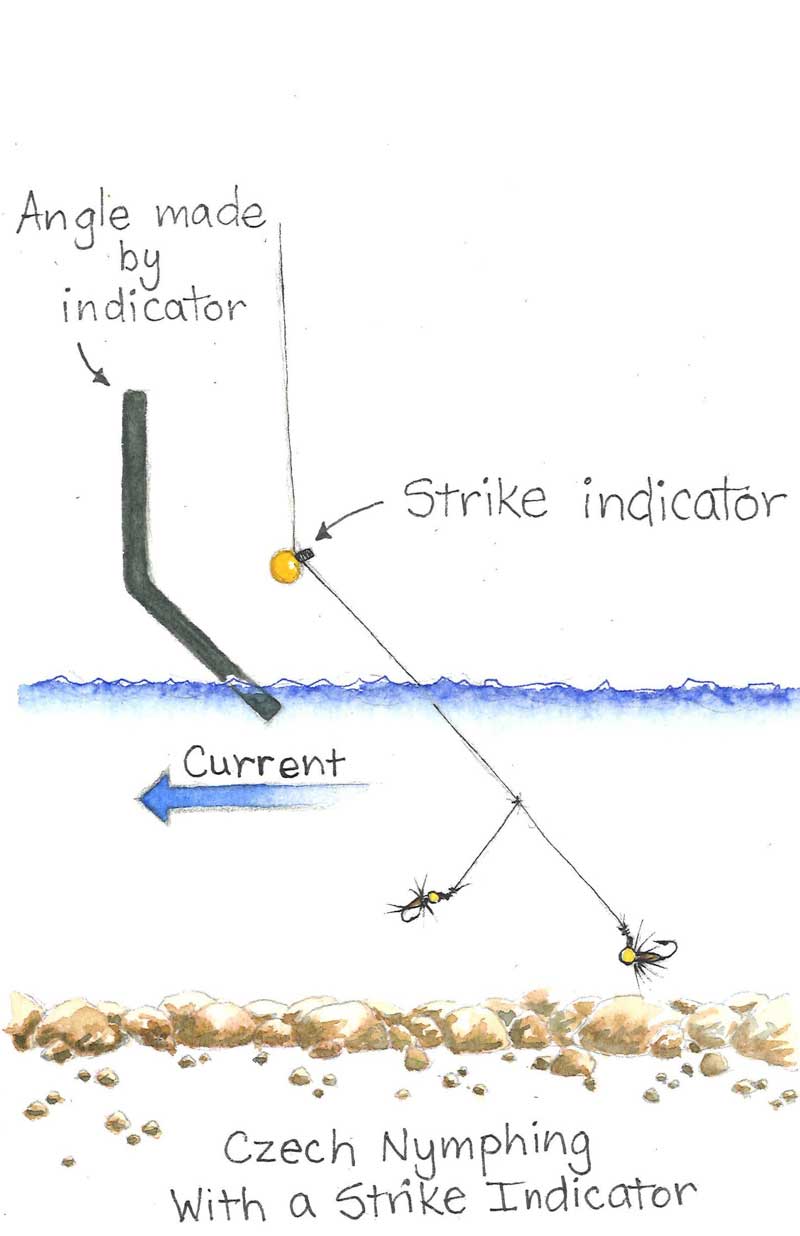
Multiple-nymph rig, no sighter but a strike indicator instead, still leading the flies with the rod-tip: this is Czech nymphing with an indicator. | Carol Ann Morris illustration
If I’m indicator nymphing and want to switch to Czech style, I move the indicator up the leader to about the point I’d normally cut in the sighter. Then I flip the nymphs upstream and lead them down in just the way Czech nymphing requires—and use my indicator as a sighter. If the indicator does anything suspicious, I set. I really like using the indicator this way; its weight puts an angle in the leader, and I find it easy to read any changes in that angle. (Though that weight also restricts me to close-in Czech nymphing. But so what? Fishing a nymph close in is probably the most effective way to fish a nymph in a stream.)
When I want to go back to standard indicator fishing, I just reposition the indicator on the leader.
The old and very effective dropper-nymph rig for indicator nymphing is pretty much a Czech nymphing rig, so, no problem there: I just use one rig for both nymph-fishing styles.
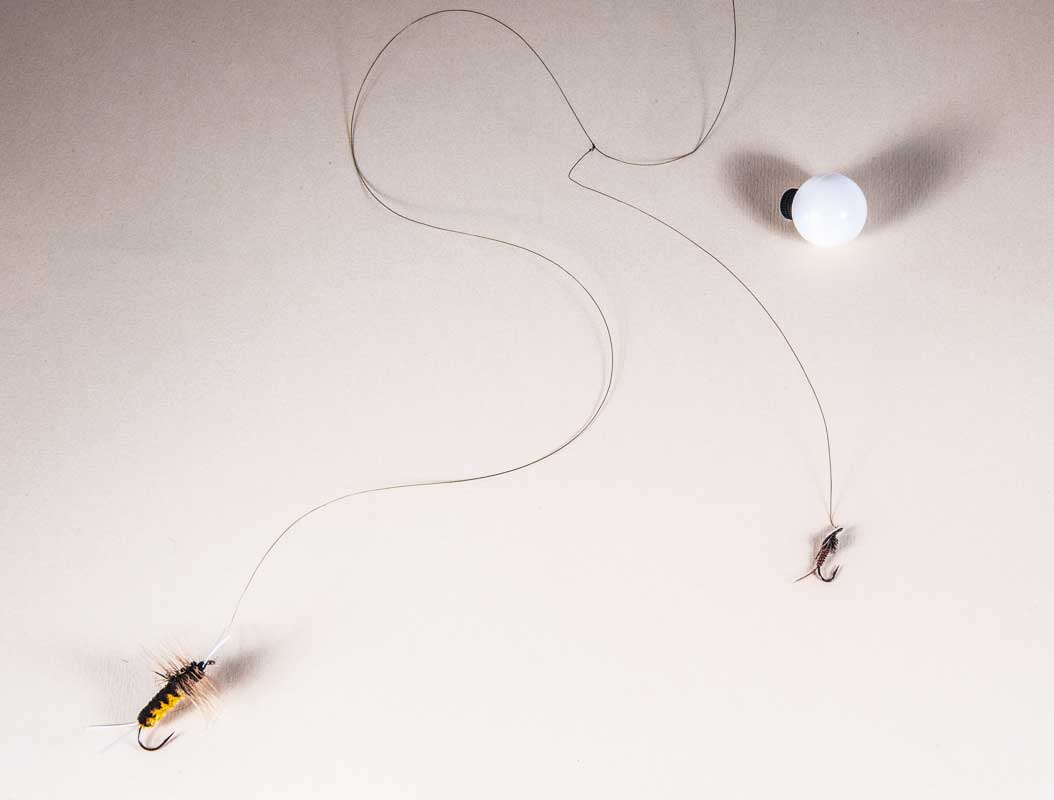
This could be an old-style dropper rig for indicator nymph fishing or a rig for Czech nymphing. To me, it’s both. The point (bottom) nymph is the heaviest, and a foot to two feet up the tippet, attached to only a few inches of tippet, is the lighter-weight (often smaller) dropper nymph. | Carol Ann Morris photo
Tip 367
See Branch or Log Trouble on Your Stream? Look Again
(This tip applies to trout in streams and smallmouth bass in streams.)
Trout especially, but sometimes smallmouth bass, will hold under or just down-current from tree branches, fallen trees, from whatever extends out over a stream. These fishes are wise to do so—a log or a leafy branch obscures them from the eyes of hungry overhead predators, offers physical protection too. But how do you get a fly under there?

The author’s fishing-mad wife, Carol Ann, crouches on a creek bank to avoid spooking the trout she seeks to hook on her dry fly. The arrow indicates a branch extending out low over the water—over a spot where trout are rising. | Skip Morris photo
Frankly, no matter how steadily and appealingly a fine trout is rising back under a low branch, drifting a fly to him can be impossible—leaves and twigs and such may be touching water all around the fish, so that a floating fly drifted down in there will catch on something every time. Something, that is, other than the trout.
So you abandon this riser and head on upstream, looking for another. Just like everyone else who’s come to this spot. The trout continues rising in peace. But… wait.
I’m sure I’ve made the following mistake many times: I saw the outstretched log or branches, but didn’t look closely at the top of the water.
Some years ago, I wised up. Here’s what I figured out: when I see a branch or log low over what looks like real fishy water, I need to take a long second look. What I see in that second look, sometimes, is water free of anything quite reaching it.
My point: Just because something extends out low over the water, that doesn’t mean any part of it is actually touching the water. Once I caught onto this I began finding even some big tangles of branches and leaves and old bare tree trunks that, although they were out just above the water, in fact were nowhere meeting the water underneath.
So what do you do once you’ve determined you actually can drift a fly back under whatever’s there? You toss in your fly, of course.
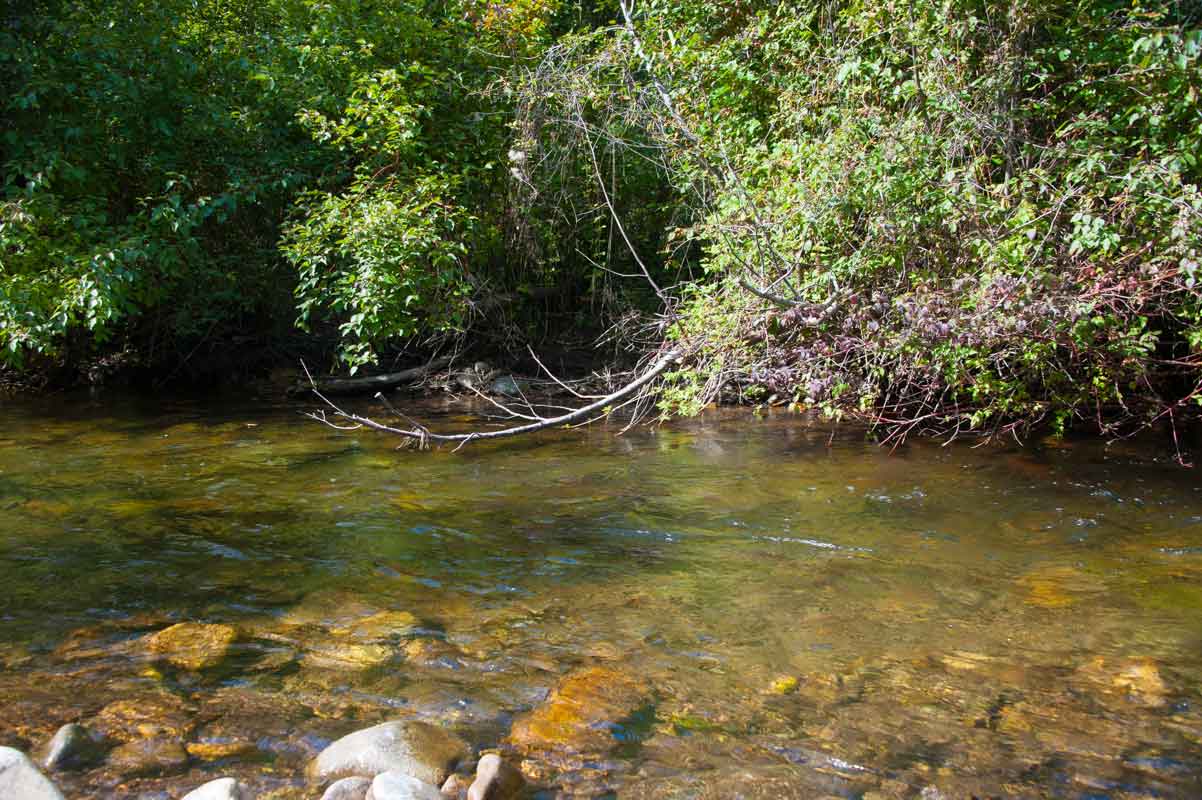
A closer look suggests that a dry fly just might get through that spot without hooking some part of the branch. So, look closer yet. | Carol Ann Morris photo
Now your Parachute Adams is riding the current just under a low ceiling of branches—but what do you do when a trout takes your fly? You set the hook, of course—and you set low, keeping rod-tip down perhaps almost to the water. If you raise your rod to set, you pull your line, and perhaps your leader and tippet, up into all the potential snags of those branches, of their leaves and twigs.
Sometimes one big fish fish or perhaps several good fish are holding under stream-side overhang that other fly fishers completely avoid. Others, yes, but now, not you.
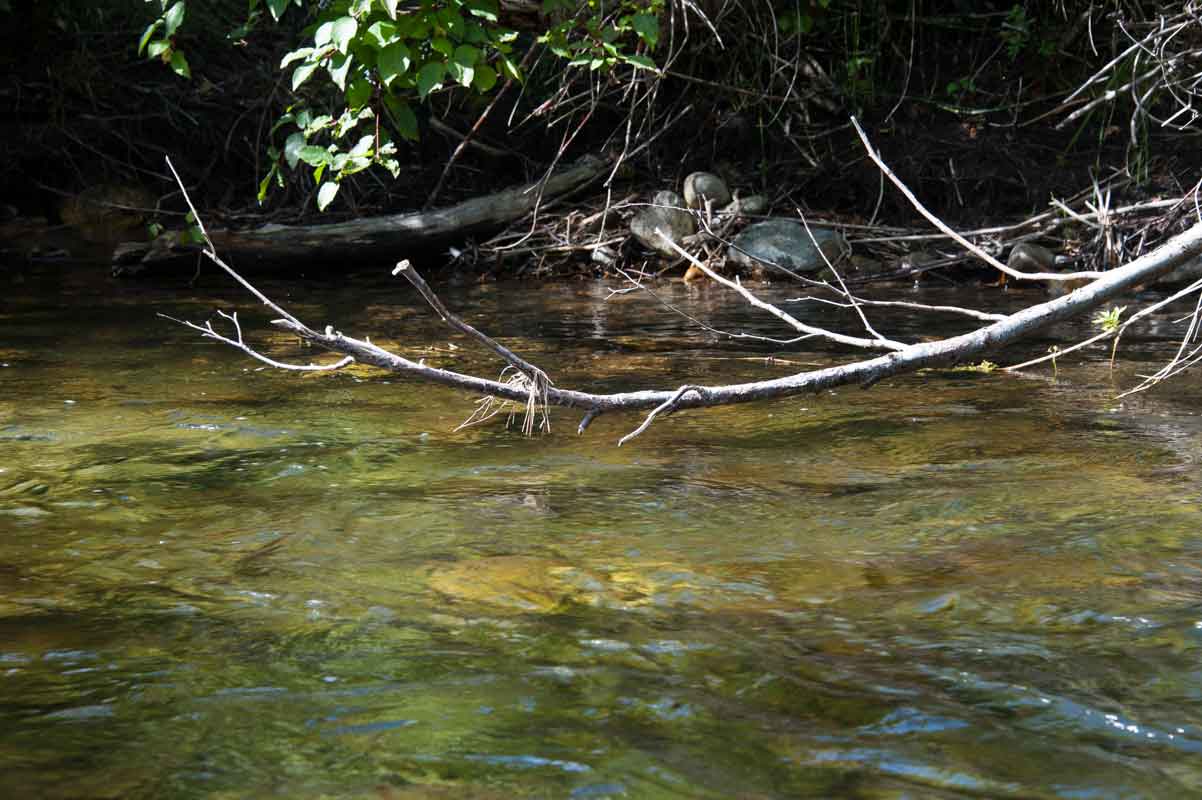
Aha—neither the branch nor its bare, stubby sub-branches are quite touching the water! In fact, Carol did drift a dry under there and she did hook a couple of wild cutthroat by doing so. (And hooked them despite the dubious mental stability of this kind of trout. But we’ll get to that soon.) | Carol Ann Morris photo
Tip 368
There Are Advantages to Sticking With Reels of One Size and Model
(This tip applies to trout in streams and lakes, largemouth bass in lakes, smallmouth bass in streams and lakes, and panfish in lakes.)
When a fly fisher’s eyes brighten at seeing rows of elegant, gleaming fly reels inside a fly shop’s glass display case, it’s natural for him or her to want the whole collection—but how many fly fishers can afford to clean out a shop’s reel inventory? Few. So instead, our fly fisher will typically look at lots of reels, buy one finally, and then after a year (or two or three…), look at more reels and buy another of some other make and model. Maybe after a while buy yet another reel of yet another design. This approach eventually results in our fly fisher owning a few different reels from different manufacturers: no duplicates.
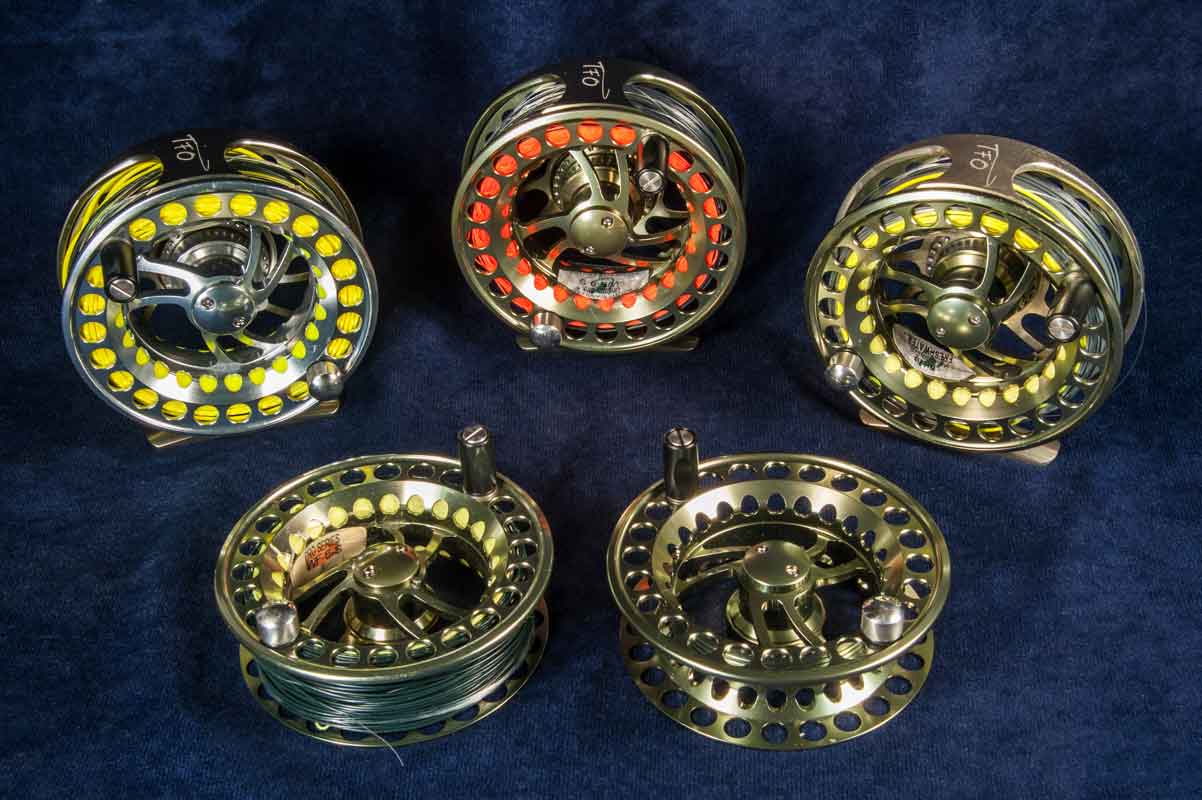
All these reel frames and reel spools are of one brand, one model, one size—mix and match as you like. You literally cannot make a mistake. | Carol Ann Morris photo
But duplicate reels are good.
Scenario: You own one X series reel from the X Fly-Reel Company, the 5-weight-line model in the series. You also own a reel from the Y series made by the Y Fly-Reel Company, again, the five-weight model. Your third reel is a Z series from the Z Reel Company and is also for a 5 line. Three 5-weight reels, each a different design from the others.
“Fine,” you say. “What’s the problem with any of that?”
Actually, there are a few problems. Let me show you.
Problem #1 You drop the Y reel and bend the frame (or the drag starts failing or the foot breaks . . .). Now the reel’s frame is shot but the reel’s spool, a spool carrying an expensive new line, is unharmed. Congratulations: you have a spool and line and no reel frame that will fit it—that spool certainly won’t fit in your X or Z reel frames.
But if all your reels were Y model 5-liners, you could just slip the spool-who’s-lost-its-frame into one of your other Y-model frames whenever you want to fish the line that’s on that spool.
Problem #2 You grab a reel with a full-floating line on it and a spool carrying a sink-tip line, drive an hour to the river, and find you need the sink-tip after all. So you pop the floating-line spool out of your reel frame, go to put the sink-tip spool into that frame, and . . . find you’ve brought your Y reel—but your sink-tip line is on your X spool. Sorry: you won’t be fishing that sink-tip today.
But if all your 5-weight reels were identical, same brand and same model, this disaster not only wouldn’t happen, but so long as you grab only 5-weight spools and reels, it couldn’t.
Problem #3 You pack a bunch of reels and extra spools, the spools carrying various floating and sinking lines, for a long trip—now, as you switch out spools and their lines with each day’s change of river or lake, you’ve got a messy challenge getting the right spools matched up with the right frames thanks to mismatching reel models.
But with duplicate reels and their duplicate spools? Cinch.
My point, then: Once you’ve chosen a line weight, do some research, shop around, collect up advice, and then commit to a specific model and brand of reel suited to your chosen line weight—and buy exactly that model and size when you buy your next reel, or even your next two or three reels, for that line weight.
Imagine how comforting, to avoid problems #1, #2, and #3 (and perhaps a few more I missed), by just sticking with one fine reel design.
Tip 369
Here’s How to Cope with the Committee
(This tip applies to smallmouth bass in streams and lakes.)
I spoke in the Deep South a few years ago and a well-spoken woman asked me how to catch smallmouth that have grouped to stare rudely up at her. She called such bass the Committee. A laugh jumped out of me when I heard her say it—that’s a great term for such fish behavior. But I knew just what she was talking about.
My first advice to her: Don’t get seen. Stay low, back from the water if necessary, present your fly upstream—simply put: in general, use stealth. But smallmouths have impressive eyesight and sometimes, despite your finest efforts, they’ll see you first, see you walking the stream bank or wading the shallows, and they’ll swim in for a look. They may be smallmouths large enough that you want to hook them. So, when stealth fails . . .
My second bit of advice: Slip a streamer up to them from behind. Gawking smallmouths will often come pretty close in. Close enough in that you can flip a weighted streamer out just past them and swim it back at about their depth while holding all your alarming fly line up off the water.
When a streamer swims up from behind a smallie, appearing within inches out of nowhere, instincts light up—the smallmouth will often turn and grab before it thinks. My wife, Carol Ann, worked this out after facing a number of smallmouth Committees on Oregon’s Lower Umpqua River.
My third and last advice: Try a crayfish fly. Smallies are truly crayfish addicts. Drop a small weighted one near enough the fish to be seen by their sharp eyes but not so close you frighten them off. Then creep the fly across the stream bed less than an inch at a time between pauses. That’s going to be difficult for a smallmouth to just swim away from. Of course, you’ll need calm water for this tactic so you can see what’s going on and so the fly isn’t dragged away by currents, but slow or still clear water’s where the Committee usually forms.
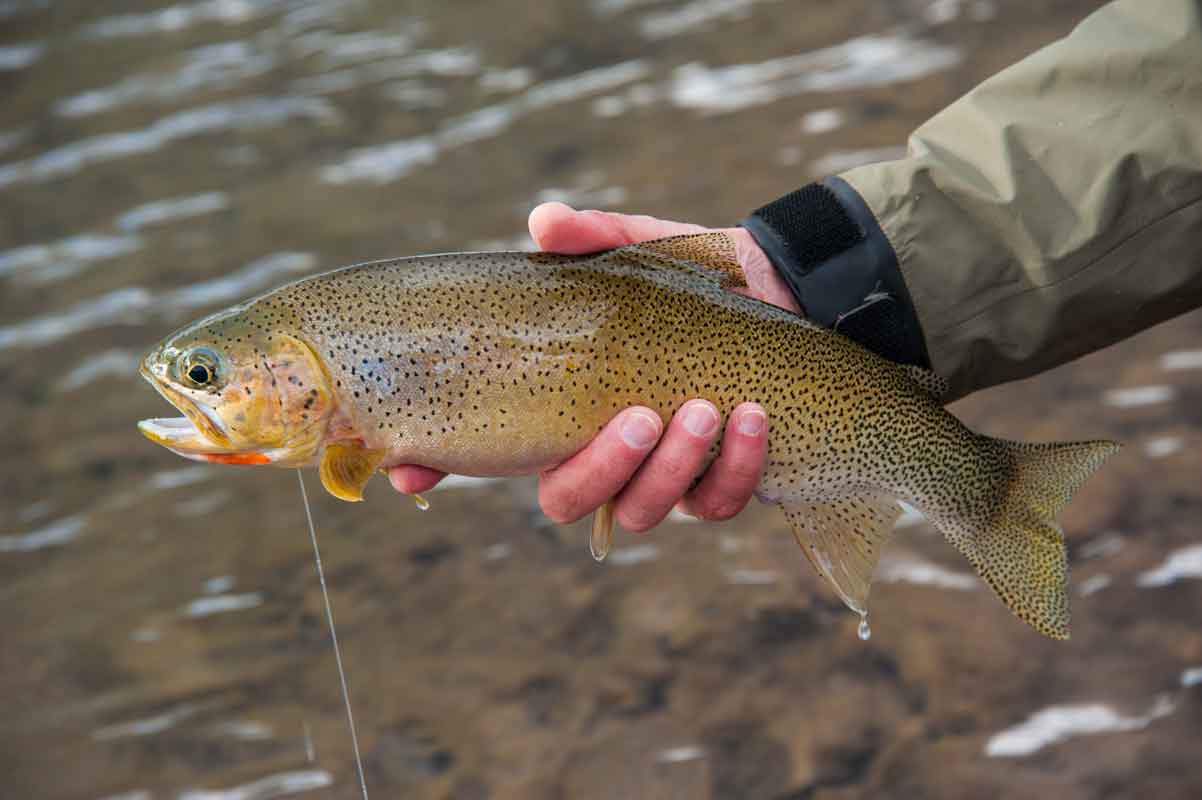
Reader: meet “Psycho.” (Albeit a handsome headcase.) | Carol Ann Morris photo
Tip 370
Cutts are Nuts
(This tip applies to trout in streams and lakes.)
The first fish I caught on a fly, way back around age 12 or 13, was a cutthroat trout, specifically, what is known as a coastal cutthroat. That was decades ago. Since then I’ve caught all kinds of cutts—Lahontans, westslopes, Yellowstones, others—and they’ve all acted insane at times. I’ve seen a Montana river full of cutts unwilling to touch any fly, despite me and Carol and two local fly-fishing guides on their day off trying fly patterns of all sorts and sizes and every trick we could muster. I’ve seen cutts in British Columbia turn down a variety of appropriate, convincing, well-fished imitative flies yet come one after another to big, absurd attractor patterns.
What I’ve seen most consistently with cutthroats though—especially with the variety I find the most illogical of them all: the westslope cutthroat—is a disdain for artificial nymphs. How many times have I drifted a proven-deadly nymph up to a westslope’s nose only to see that nose swing off to let the nymph pass? Many.
Yet often, when the cutthroats in a river won’t take a nymph, the cutts in the river the next valley over fall to nymphs as long as I keep tossing them in. And it’s not just timing—I can switch from one river one day to the other the next, and back, and get the same results: the nymph-useless river doesn’t budge, the nymph-friendly river keeps giving me hookups on Bead-Head Prince Nymphs and Gold Ribbed Hare’s Ears. Crazy, eh?
Here’s what to do the next time you’re fishing nymphs in a cutthroat stream and getting no takers: switch to a dry fly, and fish it dead drift. If that fails, go to a bigger dry fly. Then to a crazy one (that is, to an an attractor). And if that fails too, then try twitching whatever dries you put out there with the cutts. Odds are good that if they won’t get near a nymph, they’ll move to some dry fly or another presented one way or another.
Of course, tomorrow on that same stream you may not be able to keep those same cutts away from a nymph.
If there’s a primary point to all this, the one above all others, it’s this: Keep an especially open mind when fishing for cutthroat trout—getting them to take when they’re in a mood may require some wild experiments, and the solution may not make sense to you. That’s alright. You don’t need to understand cutthroats, you just need to catch them.
Tip 371
Pick a State, Any State
(This tip applies to trout in streams and lakes, largemouth bass in lakes, smallmouth bass in streams and lakes, and panfish in lakes.)
Have you purchased an out-of-state fishing license lately? If not, and you’re about to, then brace yourself. These days, the fish-and-game departments of the states I most often fish offer interesting options, options that dictate my fishing-destination choices. And perhaps they should at least influence yours.
What states do I fish most often? I live in Washington State so of course I fish here all the time. Some years I do fish farther off east and south: Tennessee, Maryland, Arizona, Michigan, etc., etc. But when I’m not fishing my home state, I’m usually fishing Oregon, Montana, Idaho, or British Columbia, just one per year.
I pick one among them each year because it saves me and Carol a significant chunk of money (and because saving money is a survival requirement if you make the modest-at-best income of a fly-fishing writer and speaker). It’s all about those fish-and-game options I mentioned, the ones I find so… interesting (actually, “disturbing” or “annoying” is a better adjective): as a nonresident I can pay a lot to fish another state or province for one week, but to fish there for an entire year costs me only a tad more.
But enough about me. Let’s say you plan a three-week trip that takes you for one week each to Montana, Idaho, and Oregon. Sounds fun, right? I used to do exactly that back in the old days. But a one-week license for each state might run you $90.00, whereas a year-long out-of-state license might only run $110.00. Here’s the math:
One-week licenses for all three states: $270.00.
One annual license for one state: $110.00.
So if you limit your out-of-state fishing to one state (or Canadian province), returning there as often and for as long as you like for an entire year, you save $160.00. And (back to me) since Carol and I nearly always take our long-distance fishing trips together, we save each year $320.00. That money could buy a lot of fly-tying materials, or groceries.
Look, if you’re going to fish Idaho and Montana and British Columbia in the next three years, does it really matter if you fish all three each year or instead fish each on a different year? Doesn’t matter to me. At least it doesn’t matter 320 bucks-worth to me.

Who wouldn’t want to catch a small, pretty pumpkinseed sunfish like this? Well, you, perhaps. I get it: you, as a seasoned fly fisher, may have lost interest in fish whose heft barely registers in your hand. Still, this little scrapper grabbed a floating Predator foam fly and made a show on top of the water while doing it, a show to delight the beginning fly fisher. Better yet: pumpkinseeds often come in big numbers and that means lots of fishing action, which newbie fly fishers need. (Writing this, I’m feeling a strange compulsion to go catch some pumpkinseeds.) | Carol Ann Morris photo
Tip 372
Newbies Need Action (and Comfort)
(This tip applies to trout in streams and lakes, largemouth bass in lakes, smallmouth bass in streams and lakes, and panfish in lakes.)
I had a friend who was a skilled and knowledgeable but unwise fly fisher and who knew a guy who wanted to try fly fishing. My friend explained the fishing process to the guy, took him out on a lawn and taught him to cast, loaned him all the required tackle, and then took him winter largemouth bass fishing on a breezy day.
Later my friend said to me of his student, “I thought he was interested, but he doesn’t want to go out even one more time.”
Let’s take stock. Out in a boat on a chilly, dark winter day, especially with any wind at all, is at best uncomfortable, at worst true misery. My friend’s and the guy’s day was windy, and though it was not quite cold enough to turn the rain to snow, there was cold rain. Largemouths up here in the North are sullen and hard to catch when the water isn’t at least warmish—and lakes here are nowhere close to warm in winter. So my friend’s guy was shivering, wet, unhappy (well, duh—who’s happy when they’re wet and shivering?), and never got a tug on his line.
See? I told you my friend was unwise.
Here’s how to wisely introduce someone to our sport.
Take them somewhere they’re bound to get action.
Fish size doesn’t matter to new fly fishers—they hardly understand big fish versus small yet and certainly don’t care. They just want to feel a fish on the line, and gain a little confidence. Small, ovoid bluegills in abundance, eager to feed in the shade on a warm June evening, will make a newbie much happier than will January bass. And a pond full of small, innocent, planted rainbow trout is much better than a spring creek of hefty browns so angler-wise that even the sharpest locals hook only one to four—often, none—in a day’s fishing.
Take them somewhere comfortable.
A big river, angry and frightening in high water, is no place to introduce someone to fly fishing. Cold or otherwise unpleasant weather’s no good. A creek easy to get around on and full of little brook trout in midsummer is the sort of time and place to start someone out.
So don’t frighten, discourage, drench, or nearly freeze some man or woman, girl or boy who wants to join us in our grand old sport. Provide them a pleasant time and some willing fish, and if they’ve got the genetics to love fly fishing, they will.
***
And there they are: seven eminently practical fly-fishing tips I came around to after the book was done (actually, that I remembered after the book)—a considerable variety. May they make your fly-fishing life at a tad easier, your fish catching a tad better. Perhaps even more than a tad?
Hope so.
You can purchase Skip’s book “365 Fly-Fishing Tips” right now through MidCurrent
